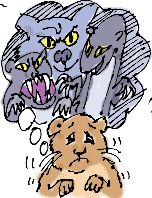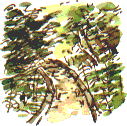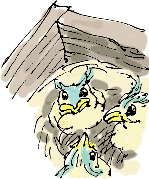
 I’VE
NEVER BEEN entirely convinced by the argument that ‘gamekeepers
make the best conservationists’ but, if I was a dormouse about
to be released into a wood as part of a reintroduction programme, I think that
I’d
prefer one where the populations of weasels, stoats and foxes were
controlled, (‘controlled’ being
a euphemism for snared and shot).
I’VE
NEVER BEEN entirely convinced by the argument that ‘gamekeepers
make the best conservationists’ but, if I was a dormouse about
to be released into a wood as part of a reintroduction programme, I think that
I’d
prefer one where the populations of weasels, stoats and foxes were
controlled, (‘controlled’ being
a euphemism for snared and shot).
Barbara and I and other members of the Wakefield
Naturalists’ Society
have been invited to assist members of the Yorkshire Wildlife Trust and Yorkshire
Mammal Group in their annual assessment of a dormouse reintroduction project
in a large keepered wood on a private estate not far from Fountains Abbey,
North Yorkshire.
There are 380 nestboxes to check, which sounds an impossible
task, but they’re
all numbered and arranged in lines, one every 15 or 20 yards,
across sections of the wood so by dividing the lines up between small teams
we make steady progress. During the entire morning only one dormouse is found,
although a number of boxes contain the characteristic ball-of-wool-shaped
nests of dormice but these may be old or temporary nests.



In the Box

 Despite this, there’s a degree of excitement in every box you open;
usually it will be empty apart from a slug or two,
a few woodlice and
a centipede but every now and then you’ll find a blue
tit or occasionally a great tit,
sitting on eggs or some of the cute yellow-gaped, fluffily ear-tufted, surprised-looking
blue tit chicks. Other boxes contain wren’s nests. Wood
mice use the boxes but we didn’t find one in residence today. Any box containing
a paper wasps’ nest – the size and shape of an inverted onion -
gets its lid replaced quickly.
Despite this, there’s a degree of excitement in every box you open;
usually it will be empty apart from a slug or two,
a few woodlice and
a centipede but every now and then you’ll find a blue
tit or occasionally a great tit,
sitting on eggs or some of the cute yellow-gaped, fluffily ear-tufted, surprised-looking
blue tit chicks. Other boxes contain wren’s nests. Wood
mice use the boxes but we didn’t find one in residence today. Any box containing
a paper wasps’ nest – the size and shape of an inverted onion -
gets its lid replaced quickly.
One box that I opened had a nest lined with badger hairs
but we couldn’t
guess what had made it.
Honey-coloured Mouse
From a single dormouse in a box you can’t draw
any conclusions . . . but . . . it occurred to me that the one occupied box
was near the end of
a woodland ride, near the southern edge of the wood so perhaps clearings or
woodland edges are what they like.
 The boxes are spread throughout a plantation-type
woodland with plenty of broadleaved
trees
and
coppiced hazels. I believe the wood is managed with pheasants in mind (although
we didn’t
see many today, perhaps because we were bustling about so much, checking out
the nestboxes). I imagine that sunny clearings surrounded by dense coppice
would be the
ideal kind
of woodland for dormice. They like honeysuckle which thrives
in such places. The vines are probably a way for them to travel around and
we noticed the
shredded bark of honeysuckle stems incorporated into their nests.
The boxes are spread throughout a plantation-type
woodland with plenty of broadleaved
trees
and
coppiced hazels. I believe the wood is managed with pheasants in mind (although
we didn’t
see many today, perhaps because we were bustling about so much, checking out
the nestboxes). I imagine that sunny clearings surrounded by dense coppice
would be the
ideal kind
of woodland for dormice. They like honeysuckle which thrives
in such places. The vines are probably a way for them to travel around and
we noticed the
shredded bark of honeysuckle stems incorporated into their nests.
 Dormice prefer
dry, well-drained boxes to the damp ones that the slugs and woodlice congregate
in so in each team we had one person armed with a drill to make
a hole or two in the uninhabited boxes.
Dormice prefer
dry, well-drained boxes to the damp ones that the slugs and woodlice congregate
in so in each team we had one person armed with a drill to make
a hole or two in the uninhabited boxes.
Links
Yorkshire Wildlife Trust
Yorkshire Mammal Group

 I’VE
NEVER BEEN entirely convinced by the argument that ‘gamekeepers
make the best conservationists’ but, if I was a dormouse about
to be released into a wood as part of a reintroduction programme, I think that
I’d
prefer one where the populations of weasels, stoats and foxes were
controlled, (‘controlled’ being
a euphemism for snared and shot).
I’VE
NEVER BEEN entirely convinced by the argument that ‘gamekeepers
make the best conservationists’ but, if I was a dormouse about
to be released into a wood as part of a reintroduction programme, I think that
I’d
prefer one where the populations of weasels, stoats and foxes were
controlled, (‘controlled’ being
a euphemism for snared and shot).


 Despite this, there’s a degree of excitement in every box you open;
usually it will be empty apart from a slug or two,
a few woodlice and
a centipede but every now and then you’ll find a blue
tit or occasionally a great tit,
sitting on eggs or some of the cute yellow-gaped, fluffily ear-tufted, surprised-looking
blue tit chicks. Other boxes contain wren’s nests. Wood
mice use the boxes but we didn’t find one in residence today. Any box containing
a paper wasps’ nest – the size and shape of an inverted onion -
gets its lid replaced quickly.
Despite this, there’s a degree of excitement in every box you open;
usually it will be empty apart from a slug or two,
a few woodlice and
a centipede but every now and then you’ll find a blue
tit or occasionally a great tit,
sitting on eggs or some of the cute yellow-gaped, fluffily ear-tufted, surprised-looking
blue tit chicks. Other boxes contain wren’s nests. Wood
mice use the boxes but we didn’t find one in residence today. Any box containing
a paper wasps’ nest – the size and shape of an inverted onion -
gets its lid replaced quickly. The boxes are spread throughout a plantation-type
woodland with plenty of broadleaved
trees
and
coppiced hazels. I believe the wood is managed with pheasants in mind (although
we didn’t
see many today, perhaps because we were bustling about so much, checking out
the nestboxes). I imagine that sunny clearings surrounded by dense coppice
would be the
ideal kind
of woodland for dormice. They like honeysuckle which thrives
in such places. The vines are probably a way for them to travel around and
we noticed the
shredded bark of honeysuckle stems incorporated into their nests.
The boxes are spread throughout a plantation-type
woodland with plenty of broadleaved
trees
and
coppiced hazels. I believe the wood is managed with pheasants in mind (although
we didn’t
see many today, perhaps because we were bustling about so much, checking out
the nestboxes). I imagine that sunny clearings surrounded by dense coppice
would be the
ideal kind
of woodland for dormice. They like honeysuckle which thrives
in such places. The vines are probably a way for them to travel around and
we noticed the
shredded bark of honeysuckle stems incorporated into their nests. Dormice prefer
dry, well-drained boxes to the damp ones that the slugs and woodlice congregate
in so in each team we had one person armed with a drill to make
a hole or two in the uninhabited boxes.
Dormice prefer
dry, well-drained boxes to the damp ones that the slugs and woodlice congregate
in so in each team we had one person armed with a drill to make
a hole or two in the uninhabited boxes.